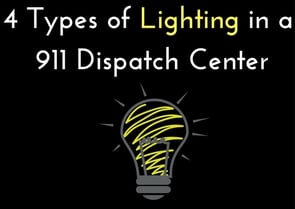 There are four types of lighting in a 911 dispatch center. There isn’t a right or wrong way to go about it, and each center utilizes a different approach when it comes to illumination. Similarly, each shift will use lighting differently based on the preferences of dispatchers and the time of day. Heck, even each dispatcher will have a different opinion on which lighting option is best for them.
There are four types of lighting in a 911 dispatch center. There isn’t a right or wrong way to go about it, and each center utilizes a different approach when it comes to illumination. Similarly, each shift will use lighting differently based on the preferences of dispatchers and the time of day. Heck, even each dispatcher will have a different opinion on which lighting option is best for them.
To help you figure out which lighting is best for you, here are a few common lighting options we see in a 911 dispatch center:
Ceiling Lighting
The first option is the ceiling lighting, and this typically consists of fluorescent lights or can lights, which are traditional incandescent bulbs. The fluorescent lights are in the traditional bulbs, and they tend to put off a kind of ugly light on everybody. I don’t know many people who are fans of these lights, as they are usually turned off because of the poor aesthetic nature. The can lights work well when it comes to getting light to the specific station, but they are rarely in the right place. These can be dimmed to just the right tone of light, but they usually are tied together for half of the room. This defeats the purpose of being able to dim the light based on individual preference.
Task Lighting
The second choice is to incorporate task lighting at each console. These are LED lights that can be dimmed and pointed at the place where you need the light. Some of these point over the monitors, and others are lowered over the keyboard surface. The current problem with these lights is that they are not quite bright enough for some of the older eyes. The other problem is that even though they are LEDs and last a long time, they are still disposable. Why no one makes LED task lights that allow you to put in new bulbs or at least swap out the heads is a mystery to me.
Bias Lighting
The third light source is bias lighting. This shines behind the monitors to give you a glow of light without shining it in your eyes. This is the same lighting that a dark theater uses on the edges of the screen to ease the contrast between the darkness in the room and the light of the screen. This works well in the dark centers by providing a gentle glow of light without lighting up the whole room.
Monitor Lighting
The fourth source of light comes from the monitors. These things put off a ton of light. They will light up most of the keyboard area as well as the space around them. This is usually enough illumination so that ceiling lights are not required, and the brightness of the monitors is also why you see many dispatch centers with their lights off.
Making the Choice
Lighting is a personal choice that each center will make. Some centers like to keep the lights on 24/7, and other centers like to change it throughout the day. A good idea, if you can, is to let in daylight during the day and use some yellow-tinted lighting options during the night. Remember each workstation can also be customized through personal lighting options, keeping things comfortable and well lit for everyone.



